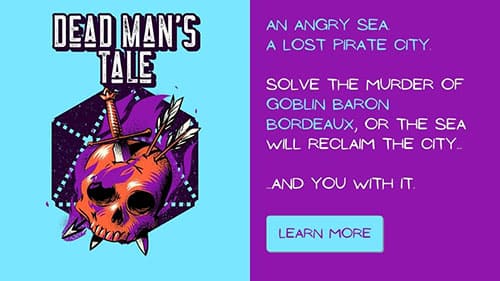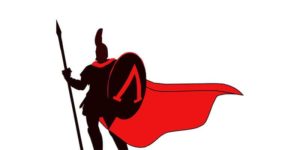Strong, stout and full of personality, dwarf paladins are legendary characters in the world of Dungeons and Dragons 5e.
When I think of dwarves, I think of their relationship to stone, metal and the earth. They are built like stone, work gemstone masterpieces and are built for tunneling. These tropes can be conveyed in character creation in many different ways. For this character, however, I’m going to focus on the stone-like strength.
Ladies and gentlemen, we’re building a tank. More precisely, we’re building a grizzled, old blacksmith turned warrior of light.
To build a dwarf paladin tank in DnD 5e, try this:
- Choose a Mountain Dwarf
- Wield a hammer and shield
- Defense or Protection fighting style
- Use boosting spells and Lay on Hands
- Divine Smite strong foes
- Choose Oath of Devotion
If you’d like to deliver dwarven justice in a world of undead pirates and bat monsters, check out my original Dead Man’s Tale adventure. Click here or below for more information.
Choose a Mountain Dwarf
Let’s begin with the basic dwarf traits and how they affect the character.
All dwarves receive a +2 Constitution bonus, an effect that adds to raw HP and resistances. As a paladin tank, this will clearly be important. My top 3 ability scores need to be Constitution, Strength and Charisma.
Being smaller in size, I have a 25 ft walking speed, though heavy armor doesn’t hinder me. I also receive Darkvision (for those dim tunnels), Dwarven Resilience, which grants me advantage on saving throws against poison, and proficiency with axes and hammers. Classic dwarf stuff, right?
A couple of other cool features include Tool Proficiency, which grants me proficiency with my choice of artisan tools, and Stonecunning, which gives me unique knowledge on stone craft. As I mentioned, I want this guy to have the flavor of a blacksmith, so I’ll give him blacksmith tools. This craftsmanship should come in handy at some point in the adventure.
I’ll choose mountain dwarf because, holy moly, I receive another +2 Strength bonus. This guy has to be the most stacked with bonuses in the game. Now, both of my most important ability scores have significant bonuses.
Wield a hammer and shield
Being both a tank and a blacksmith, I felt this combination was only right.
In one hand, I’ll carry a shield, granting me another +2 to my armor class. A shield will also be important if I were to choose the Protection fighting style, as it is a necessary component. My overall goal is to pull aggression—a classic tank strategy. I’ll want to be as armored as possible.
In the other hand, I’ll wield a warhammer. This versatile weapon deals 1d8 bludgeoning damage, with the option to carry in two hands (1d10). If I’m feeling frisky, I can choose to drop my shield and go all in. Plus, the hammer fits my blacksmith vibe.
Related Posts:
Guide to Building a Paladin Oath of Glory: DnD 5e
| Guide to Building a Rune Knight Fighter: DnD 5e
|
Defense or Protection fighting style
Now that we have our shield and hammer, choosing a fighting style to complement this set up is important. If I’m going to play a tank, I should consider how to optimize that role.
Protection fighting style is meant to draw aggression, at least from intelligent enemies. While I’m using a shield, allies within 5 feet of me receive a perk. Enemies have disadvantage on attack rolls against my teammates. Unless they’re mindless creatures reacting on instinct, I’ll likely pull that aggression. Come at my shield, brah.
Defense fighting style is much more basic in concept. It offers me a +1 bonus to my AC. It’s easy to see a “1” and think oh big deal, but this bonus places my AC at 19. That’s almost 20. As a functional defense expert, this technically makes me the better defender.
Use boosting spells and Lay on Hands
I’ll need more than my armor and fighting style, I’ll need to be a capable defender in play. Fortunately, the paladin class gives me magic options to use as well.
If we wanted to utilize a touch of the Protection fighting style, but chose the Defensive style, I could choose the spell compelled duel. This spell draws a creature’s attention to me, giving it disadvantage on rolls against my buddies. Bless can crank up my friends’ attack and saving rolls as well.
Lay on Hands is a paladin ability that offers me the ability to heal or cure a party member, including myself. The pool I draw from is my paladin level times 5. Not impressive at first, but it becomes significant soon. Curing a poison or disease costs 5 of those hit points. In this way, I can act as a party healer, though only to a certain degree.
Divine Health will cover my own immunity to disease, so it’s kind of the best of medical and defensive aspects of the class.
Divine Smite strong foes
Closing in on level 3, we start to get spicy. Divine Smite is the big show for paladins, offering 2d8 extra damage on a melee attack, or 3d8 against an undead or fiendish foe.
The idea is that my hammer charges with radiant light, effectively making it super powered. It does use a spell slot, which I generally save for these attacks. Also, I can wait until I land a hit before activating this ability. That way, I don’t have to risk wasting them.
I want to save this ability for stronger foes or strategically important moments. Sure, there will be times when I should clear the battlefield. And maybe a Divine Smite will be in order for that given situation. However, I generally want to save them for boss fights. The concept is like a boxer: I’ll want to throw a few jabs before the knock-out punch.
The extra damage increases as I level up, reaching 5d8.
Choose Oath of Devotion
Sometimes, classics feel right for a character, and Oath of Devotion is definitely a classic paladin.
This path is thematically connected to light and goodness—the classic white knight. I could argue that this devotion is also the most fiercely opposed to the forces of evil. The radiant effects are going to look cool on my hammer.
This oath is also the most defensive in nature, granting me the spells protection from evil and good and sanctuary. As you might have guess, both of these spells are used to thwart the effects of evil magic. At level 5, I’m granted lesser restoration and zone of truth—my zone of protection is going to get crazy.
Like a good mother goose, I’m gonna protect my own.
But wait, there’s more damage to dish out as well. Sacred Weapon allows me to imbue my hammer with positive energy. With this vibey infusion, I’ll add my Charisma modifier to my damage rolls. To activate this ability, I’ll need to use an action, but it lasts long enough for a battle.
Turn the Unholy is another ability I can use. Essentially, I make zombies run when I channel my holy relic. Each fiend and undead must run the opposite direction on a failed Wisdom saving throw. Seriously, at this point my advantages on these monsters are getting silly.
So, what do you think?
Dwarves make natural paladins—built with Strength and Constitution. The proficiency with hammers is a special attribute for both dwarves and paladins. Combine the combat of a hammer with the character attributes of a blacksmith, and we get a classic character. Plus, he’s actually helpful outside of combat.
Check out other character builds
Top Dragons in TV and Movies: What They Mean
| Guide to Building a Cleric Domain of Light: DnD 5e
|
Disclaimer:
Genre Bomb is unofficial Fan Content permitted under the Fan Content Policy. Not approved/endorsed by Wizards. Portions of the materials used are property of Wizards of the Coast. ©Wizards of the Coast LLC.






